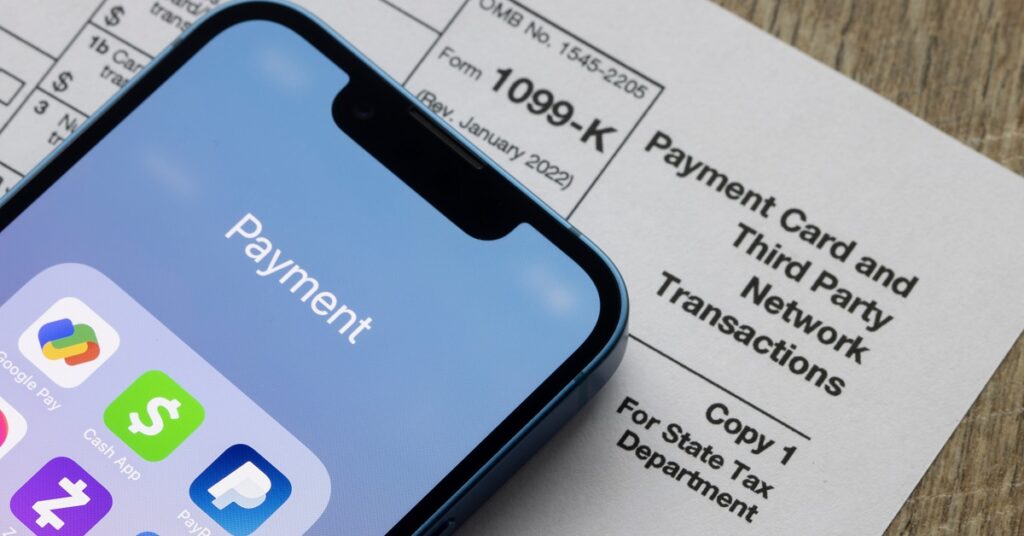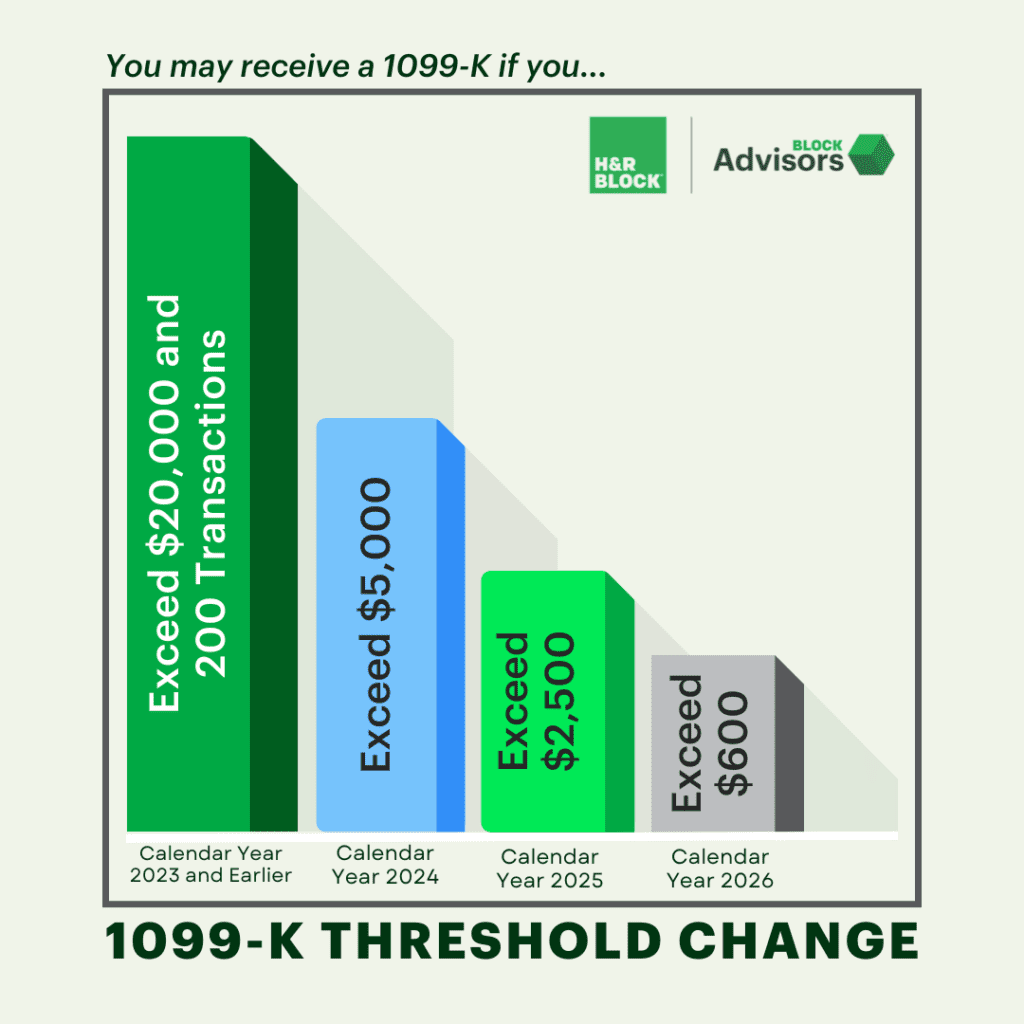Form 1099-K: Reporting Requirements for 1099-K Income
6 min read
December 20, 2024 • Block Advisors
Alert: Originally, the threshold for third-party payors to issue Form 1099-K was over $20,000 in payments and more than 200 transactions annually. A 2021 tax law reduced the threshold to $600 in payments for any number of transactions. Under IRS transition guidance, the previous $20,000 and 200 transaction threshold remained in place for tax years 2022 and 2023. Under new guidance released in late 2024, the 1099-K reporting threshold for calendar year 2024 will be over $5,000 in payments. In calendar year 2025, the threshold will drop to over $2,500 in payments. Starting in calendar year 2026, the $600 threshold will take effect. Please continue to check back for future updates.
The world of business is highly digital in most aspects – including finances. Gone are the days when small business owners exclusively made cash transactions.

So, you might wonder how the IRS tracks online business transactions. That’s where the 1099-K form comes in.
The IRS debuted the form for the 2012 tax filing season to support the growing demand for online business transactions (including IRS Form 1120, 1120-S, and self-employed taxpayers and Form 1065 filers).
Like other forms in the 1099 series, the form has an important purpose – reporting credit card and third-party transactions. If that describes how your business gets paid, you should tune in as we explore the workings of the 1099-K form.
Do you have questions about a 1099-K you received? The team at Block Advisors can help you with your small business taxes.
What is a 1099-K used for?
First, we’ll explore the answer to the question, “What is a 1099-K used for?” Form 1099-K is an IRS form and is classified as an information return. It deals with card payments and third-party network transactions like Venmo, Paypal, and others. Your business uses the information on Form 1099-K when it files a tax return.

*NEW IN CALENDAR YEAR 2024* The IRS has announced a phased transition. For calendar year 2024 (taxes filed in the 2025 filing season), Form 1099-K will be issued to small business owners from third-party services that processed more than $5,000 worth of payments, regardless of the number of individual payments or transactions. This represents a significant decrease in the reporting threshold in prior years.
For calendar year 2025, the threshold will drop to more than $2,500 in payments. Starting in calendar year 2026, a threshold of more than $600 worth of payments will take effect.
For 2023 and previous years: Form 1099-K was issued to small business owners who exceeded the $20,000 reporting threshold and had more than 200 transactions through a third-party payment service.
What if you don’t meet these requirements? Even if you don’t receive a Form 1099-K because of your business income from credit cards and third-party networks, you still need to report all business income you receive on your tax return. (Read more: Is crowdfunding taxable?)
How is 1099-K income reported?
There’s not really an answer to: “How to file a 1099-K?” That’s because, technically, YOU don’t file it as a small business owner. This is the responsibility of the third-party payment processors and credit card companies. They will report the payment transactions by filing Form 1099-K with the IRS. You will receive a copy of the form in the mail or electronically. No action is necessary for you, the small business owner.
But here’s an action: Make sure your tax statements match the IRS’ transaction records.
Need help understanding 1099-Ks?
Block Advisors small business experts have your back.
How does the IRS audit 1099-Ks?
Over the years, the Internal Revenue Service has contacted taxpayers whose gross business income is less than the amount reported on the form.
The 1099-K form is one of the information statements used to find income missing from tax returns. The IRS matches your return against the information statements filed under your Employer Identification Number (EIN), Tax Identification Number (TIN), or Social Security Number (SSN). If there’s an income mismatch, the IRS automatically sends you a notice asking for an explanation.
You may wonder how to report 1099-K income on your tax return. Thankfully, the IRS doesn’t require you to separately report the amount from every Form 1099-K on your return. However, the IRS will question businesses with smaller-than-expected income based on its analysis of Forms 1099-K reported to the business. In other words, based on what the IRS knows about your business, it may audit you if it thinks you aren’t reporting enough income from payment cards or third-party network transactions.
The IRS may not propose specific adjustments to your return based on Form 1099-K (unless you didn’t file a business return at all – such as a Schedule C, or filed one with less income than appears on Form 1099-K). The IRS may not directly match Forms 1099-K to line items on your business return. However, the IRS does contact business taxpayers when it believes there may be a discrepancy.
1099-K deductions
Let’s review what expenses you can deduct from your business income when you receive credit card payment transactions reported on a 1099-K form. While there may be others, here are some potential 1099-K deductions:
- Web hosting fees: You can deduct this if you have to pay an annual web hosting fee for your online marketplace or shop.
- Credit card or merchant processing fees: These can be deducted if you pay the credit card company processing fees.
- Internet access: Internet access for your established business entity can be deducted.
- Advertising costs: If there’s a cost associated with marketing your business, you can deduct this to reduce your taxable income.
- Home office: The small business home office deduction applies to small business owners who use part of their home exclusively and regularly for trade or business purposes. Learn more about the home office deduction and IRS Form 8829.
How to get help with IRS Form 1099-K
Ensuring tax information returns like the 1099-K form match up with your business’s books and records is critical. All sources of income and expenses are used to determine taxable income or loss. At the end of the day, forms like these help determine your business’ tax obligation.
If you want help filing self-employment taxes online because you don’t have the expertise or time to do your taxes, get help from our certified small business tax professionals.
File with a tax pro today.
Receive a 1099-K this year?
Block Advisors can help you understand what to do next.
This article is for informational purposes only. The content may not constitute the most up-to-date information and should not be construed as legal advice.




